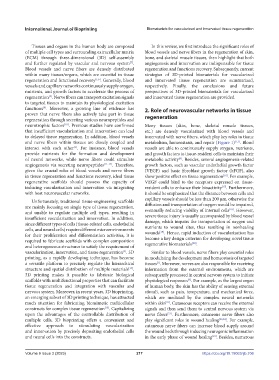Page 225 - IJB-9-3
P. 225
International Journal of Bioprinting Biomaterials for vascularized and innervated tissue regeneration
Tissues and organs in the human body are composed In this review, we first introduce the significant roles of
of multiple cell types and surrounding extracellular matrix blood vessels and nerve fibers in the regeneration of skin,
(ECM) through three-dimensional (3D) self-assembly bone, and skeletal muscle tissues, then highlight that both
and further regulated by vascular and nervous system . angiogenesis and innervation are indispensable for tissue
[7]
Blood vessels and nerve fibers are densely distributed regeneration and functions recovery. Subsequently, current
within many tissues/organs, which are essential in tissue strategies of 3D-printed biomaterials for vascularized
regeneration and functional recovery [1,6] . Generally, blood and innervated tissue regeneration are summarized,
vessels and capillary networks continuously supply oxygen, respectively. Finally, the conclusions and future
nutrients, and growth factors to accelerate the process of perspectives of 3D-printed biomaterials for vascularized
regeneration . Nerve fibers can transport excitation signals and innervated tissue regeneration are provided.
[8]
to targeted tissues to maintain its physiological excitation
functions . Moreover, a growing line of evidence has 2. Role of neurovascular networks in tissue
[9]
proven that nerve fibers also actively take part in tissue regeneration
regeneration through secreting various neuropeptides and
neurotrophic factors . Previous studies have confirmed Many tissues (skin, bone, skeletal muscle tissues,
[10]
that insufficient vascularization and innervation can lead etc.) are densely vascularized with blood vessels and
to delayed tissue regeneration. In addition, blood vessels innervated with nerve fibers, which play key roles in tissue
and nerve fibers within tissues are closely coupled and metabolism, homeostasis, and repair (Figure 1) [1,2] . Blood
interact with each other . For instance, blood vessels vessels are able to continuously supply oxygen, nutrients,
[1]
provide nutrients for the formation and development and growth factors to tissue-resident cells to maintain their
of neural networks, while nerve fibers could stimulate metabolic activity . Besides, several angiogenesis-related
[8]
angiogenesis via secreting neuropeptides [11-13] . Therefore, growth factors, such as vascular endothelial growth factor
given the crucial roles of blood vessels and nerve fibers (VEGF) and basic fibroblast growth factor (bFGF), also
in tissue regeneration and functions recovery, ideal tissue show positive effect on tissue regeneration . For example,
[16]
regenerative scaffolds should possess the capacity of VEGF could bind to the receptors expressed on tissue-
inducing vascularization and innervation via integrating resident cells to enhance their bioactivity . Furthermore,
[17]
with host neurovascular networks. it should be emphasized that the distance between cells and
Unfortunately, traditional tissue-engineering scaffolds capillary vessels should be less than 200 μm, otherwise the
are mainly focusing on single type of tissue regeneration, diffusion and transportation of oxygen would be impaired,
[18]
and unable to regulate multiple cell types, resulting in eventually reducing viability of internal cells . However,
insufficient vascularization and innervation. In addition, severe tissue injury is usually accompanied by blood vessel
since different types of cells (tissue-related cells, endothelial damage, which impairs the transportation of oxygen and
cells, and neural cells) require different microenvironments nutrients to wound sites, thus resulting in nonhealing
[19]
for their proliferation and differentiation activities, it is wounds . Hence, rapid induction of vascularization has
required to fabricate scaffolds with complex composition become a key design criterion for developing novel tissue
[20]
and heterogeneous structures to satisfy the requirement of regenerative biomaterials .
vascularization, innervation, and tissue regeneration . 3D Similar to blood vessels, nerve fibers play essential roles
[4]
printing, as a rapidly developing technique, has become in modulating the development and homeostasis of targeted
a versatile platform to precisely regulate the hierarchical tissues . Moreover, nerves are also responsible for receiving
[1]
structure and spatial distribution of multiple materials . information from the external environments, which are
[14]
3D printing makes it possible to fabricate biological subsequently processed in central nervous system to initiate
scaffolds with multifunctional properties that can facilitate physiological responses . For example, as the largest organ
[9]
tissue regeneration and integration with vascular and of human body, the skin has the ability of sensing external
nervous system. Moreover, in recent years, 3D bioprinting, stimuli, such as pain, temperature, and mechanical force,
an emerging subset of 3D printing technique, has attracted which are mediated by the complex neural networks
much attention for fabricating biomimetic multicellular within skin . Cutaneous receptors can receive the external
[21]
constructs for complex tissue regeneration . Capitalizing signals and then send them to central nervous system via
[15]
upon the advantages of the controllable distribution of nerve fibers . Furthermore, cutaneous nerve fibers also
[22]
multiple cells, 3D bioprinting offers a convenient and play significant roles in wound healing [23,24] . For example,
effective approach to stimulating vascularization cutaneous nerve fibers can increase blood supply around
and innervation by precisely depositing endothelial cells the wound beds through inducing neurogenic inflammation
and neural cells into the constructs. in the early phase of wound healing . Besides, numerous
[19]
Volume 9 Issue 3 (2023) 217 https://doi.org/10.18063/ijb.706

